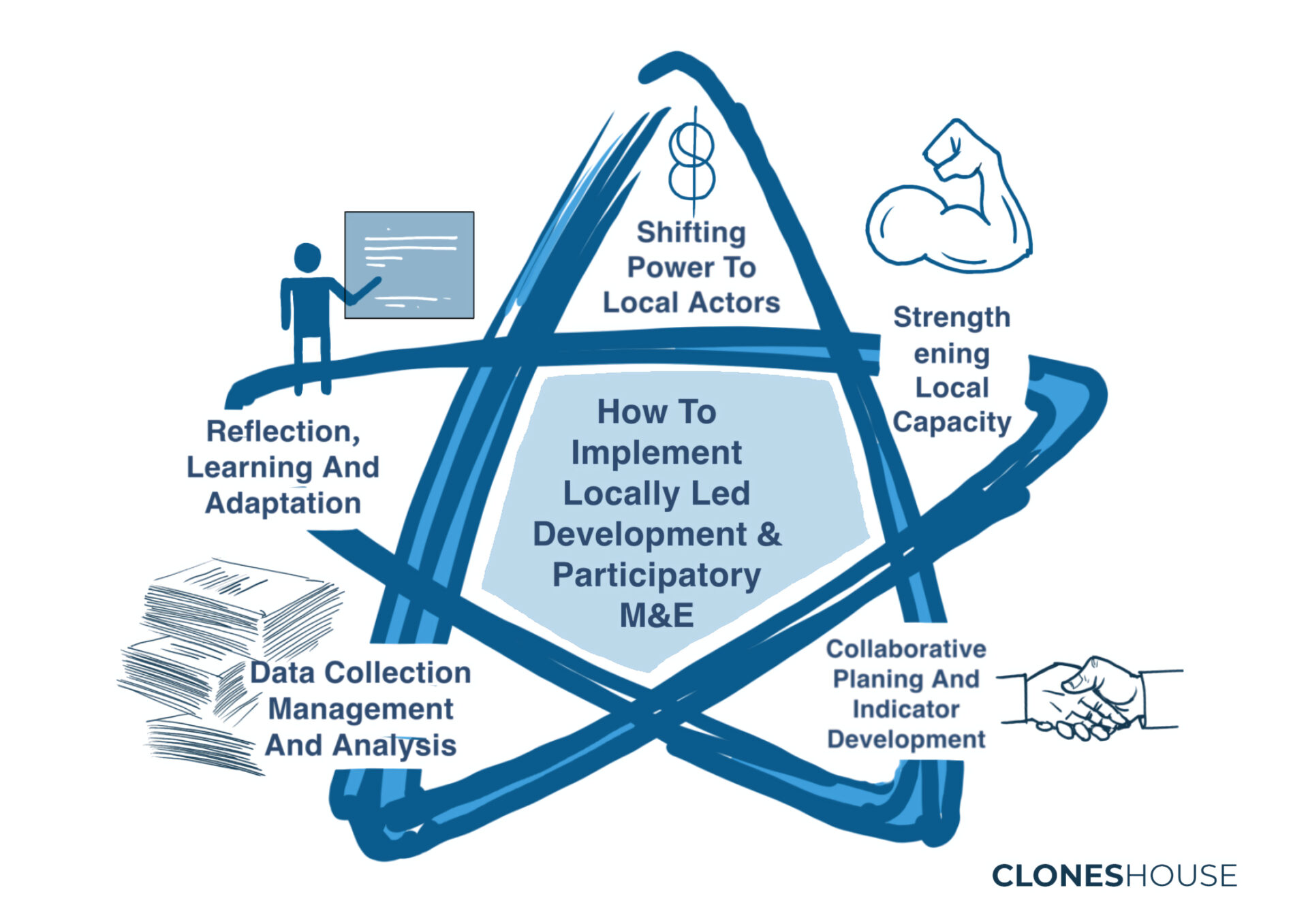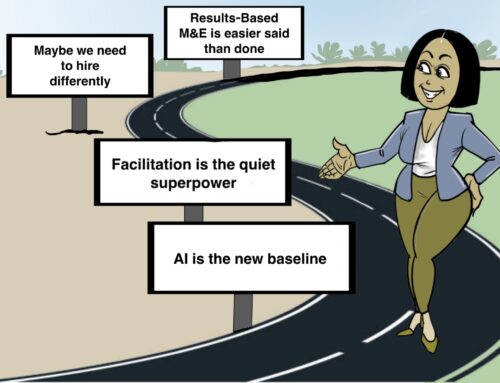“If less than 2.5% of humanitarian aid goes to local actors, shifting leadership toward local communities requires those in power to implement reforms that enable effective change”.
In the evolving scene of international development, there is increasing recognition of the importance of empowering local actors to lead and sustain development initiatives. Locally Led Development (LLD) and Participatory Monitoring and Evaluation (PM&E) prioritize community agency, ensuring that those most affected by development decisions play an active role in shaping, implementing, and assessing these initiatives. This blog explores how to implement LLD and PM&E effectively, emphasizing key strategies and frameworks that promote inclusive, sustainable outcomes.
Key Strategies for Implementing LLD and PM&E
1. Shifting Power to Local Actors
A foundation of LLD is the decentralization of decision-making power to local stakeholders. This involves allocating substantial project funding to local partners and ensuring they play a central role in designing and delivering development interventions. By fostering co-creation and collaborative proposal development, local actors gain control over defining and prioritizing their needs (Irvine and Llulla 2024). Moreover, decentralizing decision-making allows local actors to implement culturally appropriate solutions and respond quickly to emerging challenges (Soanes et al. 2021).

2. Strengthening Local Capacity
Effective implementation of LLD requires robust investment in local capacities. Providing training in monitoring methodologies, data collection tools, and project evaluation techniques equips local stakeholders to track progress independently. This capacity-building effort must be iterative and responsive to the evolving needs of the community (Mujuru 2018).
Building the capacity of local actors enables them to analyse, reflect, and act on development challenges while fostering a culture of continuous learning and adaptation. This approach leaves an institutional legacy, empowering communities to sustain and scale their development efforts beyond external funding cycles (OECD 2023).
3. Collaborative Planning and Indicator Development
Collaborative planning is a key principle of PM&E. Conducting a thorough situational analysis helps define expected outcomes and develop performance indicators tailored to local contexts. Participatory frameworks such as SPICED (Subjective, Participatory, Interpreted, Communicable, Empowering, Disaggregated) provide a comprehensive guide for selecting indicators that capture both quantitative and qualitative dimensions (Irvine and Llulla 2024).
By involving community members in defining objectives and performance measures, PM&E ensures that evaluation processes align with local realities. This participatory approach enhances the relevance of development interventions while fostering ownership and accountability.
4. Data Collection, Management, and Analysis
PM&E emphasizes the use of participatory tools to collect and analyse data. Methods such as focus group discussions, storytelling, and resource mapping capture diverse community perspectives and contextual knowledge (Hilhorst and Guijt 2006). Transparent data sharing between stakeholders strengthens mutual trust and promotes collective decision-making.
This localized approach to data collection not only improves the accuracy of evaluation outcomes but also empowers communities to interpret and act on the data. Continuous feedback loops enable real-time learning and adaptive management, allowing for timely adjustments to project strategies (Muriungi 2015).
5. Reflection, Learning, and Adaptation
A successful LLD and PM&E framework integrates mechanisms for reflection and adaptive learning. Regularly reviewing project data allows stakeholders to identify gaps and refine implementation strategies. Sharing these insights with the broader community fosters collective learning and enhances long-term resilience (Mujuru 2018).
Adaptive frameworks prioritize flexibility and responsiveness, ensuring that interventions remain relevant amid changing social, economic, and environmental conditions. This iterative process strengthens local agency and reinforces sustainability of development initiatives (Soanes et al. 2021).
Principles Guiding LLD and PM&E Implementation
Implementing LLD and PM&E effectively requires adherence to eight core principles (Soanes et al., 2021):
- Devolving decision-making to the lowest appropriate level.
- Addressing structural inequalities faced by marginalized groups.
- Providing patient and predictable funding accessible to local actors.
- Investing in local capabilities to leave an institutional legacy.
- Building a robust understanding of climate risk and uncertainty.
- Emphasizing flexible programming and iterative learning.
- Ensuring transparency and accountability throughout the process.
- Fostering collaborative action and shared investment.
These principles acknowledge the structural barriers local communities face and prioritize empowering them to lead the development process. For example, addressing gender and social inequalities ensures that women, youth, and marginalized groups are central to decision-making, fostering more inclusive outcomes (Fox and Hallock 2024).
The Imperative for Reformation
Historically, development decisions made far from local contexts have resulted in ineffective and maladaptive solutions. By centring local voices and knowledge, LLD and PM&E address these shortcomings and promote sustainable, community-driven change (Coger, Corry, and Gregorowski 2021).
In conclusion, LLD and PM&E provide a transformative approach to international development by prioritizing local leadership, participatory decision-making, and adaptive learning. Implementing these frameworks requires sustained commitment to power-sharing, capacity-building, and continuous reflection. By fostering genuine local ownership, we can advance more equitable, effective, and enduring development outcomes.
References
Coger, Tamara, Sarah Corry, and Robbie Gregorowski. 2021. “Reshaping Monitoring, Evaluation and Learning for Locally Led Adaptation.” World Resources Institute (January): 1–24.
Fox, Jonathan, and Jeffrey Hallock. 2024. “Open Government and US Development Co-Operation in Colombia: Lessons for Locally Led Development.” Development Policy Review (July).
Hilhorst, Thea, and Irene Guijt. 2006. “Participatory Monitoring and Evaluation : A Process to Support Governance and Empowerment at the Local Level.” Using participatory monitoring and evaluation to strengthen local governance (March): 54.
Irvine, Renwick, and Anjeza Llulla. 2024. “Measuring Progress towards Locally Led Development Co-Operation : Towards a Shared Framework.”
Mujuru, Vongaishe T. 2018. “Participatory Monitoring and Evaluation , Power Dynamics and Stakeholder Participation.” (August).
Muriungi, Tonny Mutuma. 2015. “The Role of Participatory Monitoring and Evaluation Programs among Government Corporations: A Case of Ewaso Ngi’ro North Development Authority.” International Academic Journal of Social Sciences and Education 1(4): 53–76. www.iajournals.org.
OECD. 2023. “Risk Management and Locally Led Development: Understanding How to Better Manage Risks for Sustainable Impact.” https://one.oecd.org/document/DCD(2023)48/en/pdf?sessionId=1700675942626.
Soanes, M et al. 2021. IIED’s Climate Change group Principles for Locally Led Adaptation: A Call to Action. http://pubs.iied.org/10211IIED.
About the Author
Lindan Mlambo, is a Fall 2024 intern at Cloneshouse. She is a trained Aquatic Ecologist passionate about sustainable development particularly initiatives that bridge the global South-North divide. She is part of the EU M&E program, contributing to development evaluation and eHealth Africa project.





